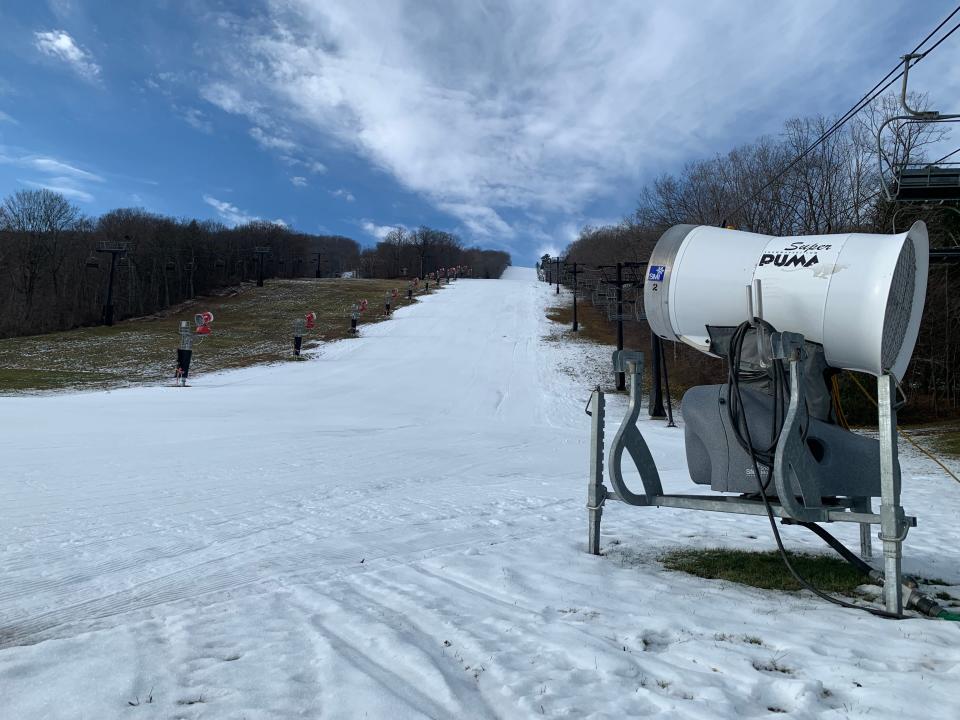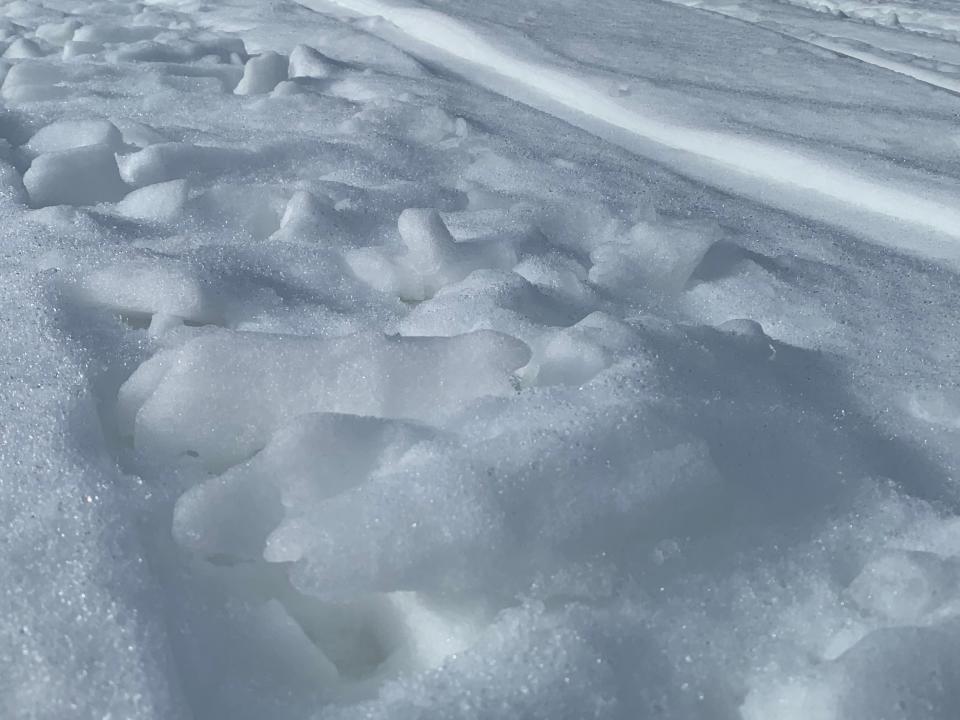Warmer weather challenges snowmaking operations at Bristol ski resort
When Paul Trippi came down from work on Bristol Mountain on a recent December morning, the mud on his boots indicated the warm weather chores being done.
Wet and seasonably warm temperatures allowed for maintenance on the miles of compressed air lines on the mountain — ground water allows crews to locate potential leaks via bubbles — though it didn’t lend itself to making additional snow.
The early season has been challenging, said Trippi, Bristol Mountain operations manager. There were three snowmaking nights the week of Dec. 3, but it has been scattershot.
“We’re getting some windows of opportunity to make snow, but they’re relatively short,” Trippi said. “And there’s quite a lot of gaps between them.”
He has been in the industry about three decades, and now is seeing chances to make snow each season become less frequent. And those making snow windows of time are often shorter, which messes with the number of consecutive days of production.
Some of the colder weather has shifted more toward springtime.
“So, instead of it just getting cold and staying cold, it gets on that roller coaster: warm to cold, warm to cold,” Trippi said.

How do ski resorts make snow?
There are miles of lines on Bristol Mountain that all feed into the resort’s snowmaking system. The water and compressed air being piped are two of the main ingredients necessary for snowmaking, along with cold weather.
A snow gun is then used to spray cooled water droplets over the ski run, causing the droplets to freeze and fall to the ground as snow. Snow made by this process generally creates good snowpack if it freezes once every 24 hours, Trippi said.
“The snow we make isn’t a snowflake,” he said. “It’s a tiny ice particle. So it handles warm weather better than natural snow does.”
Due to conditions in western New York, Trippi said there wouldn’t be a snow season at resorts like Bristol Mountain without machine-made snow. That’s not uncommon in the rest of the United States either, with 88% of the National Ski Areas Association members having machine-made snowmaking capabilities. An average of 17% of the total skiable acres in the U.S. are covered in machine-made snow.
At Bristol Mountain, the snowmaking system covers 100% of the terrain.
Snowmaking is essential in this part of the world, Trippi said, though natural snowfall does have its benefits. “It makes for a very nice surface to ski on after we put a base down,” Trippi said. “And it definitely gets people energized about skiing.”

What conditions are needed for good snow making?
It needs to be cold for snow making to work and be efficient. It takes more than just below freezing air temperatures, though.
Instead, snow making requires a "wet bulb temperature" of about 28 degrees or lower to generate snow.
What is the wet bulb temperature? It factors humidity into the outside air temperature and can be measured using a thermometer bulb wrapped in wet muslin, which is a cotton fabric, according to the National Weather Service. The wet bulb allows the thermometer to factor in the evaporative cooling effect.
The gap between the wet bulb temperature and dry bulb temperature relates to the relative humidity in the air. If the outside air is at 100% humidity, for instance, the temperatures would be the same. Typically, however, the wet bulb temperature is lower than the dry bulb temperature.
At Bristol Mountain, the cutoff point is 25 degrees wet bulb temperature. While they can make snow above that mark, it’s very inefficient, Trippi said.
If it's warmer than that outside it "takes a lot of energy to do it for very little input,” he said. “And if you look at output versus temperature in snowmaking, it’s not linear … So the amount you’re making at 27 degrees, you’re making four times that amount at 23 degrees.”
Bristol Mountain scales 1,200 feet of vertical rise, which also factors into snow production. There is typically a 5-degree difference between the top and bottom of the mountain. As a result, there’s currently more snowpack at the top of the mountain than the bottom.
How big is the snowmaking operation at Bristol Mountain?
The crew of snow makers at Bristol Mountain is typically 10 to 12 people, split between a day crew and a night crew. It’s a 24-hour operation, with a mixture of full- and part-time employees, when conditions are right, Trippi said. The full-time employees do maintenance, like the compressed air line leak repairs, when the winter is not cold enough to make snow.
Trippi said he tracks the forecast for days when they might be able to make snow. Once conditions are met, the water and compressed air lines on the hill are charged and then the snowmaking guns are started up and adjusted for snow quality. The preparation process takes one to two hours.
Early in the season, Bristol Mountain uses a wetter snow to create a base for the ski runs. As the season progresses, a drier snow is made that grooms better and is nicer to ski on.
If you go: Bristol Mountain
Bristol Mountain is located in at 5662 Route 64 in South Bristol. The resort includes 138 acres of skiable terrain, which include 39 slopes and trails.
Conditions on the mountain, including the open ski runs, available lifts and operating hours are at bristolmountain.com. There are also webcams which show current conditions, including a live feed on the Rocket trail.
More: Rochester's warm winter start brings white Christmas skepticism
More: Have a Rochester weather tip? We want to hear from you
— Steve Howe covers weather, climate and lake issues for the Democrat and Chronicle and as a native upstate New Yorker thinks fall is the best season. Have any insight into changing winter weather? Share with him at showe@gannett.com.
This article originally appeared on Rochester Democrat and Chronicle: Warmer weather challenges snowmaking operations at Bristol ski resort

